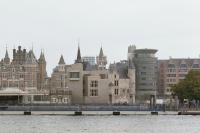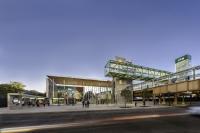Memorial for Bhopal Gas Tragedy Victims
Bhopal, India
3rd december 1984
worst industrial disaster
Union Carbide was a natural progression of the process of industrialization, and it was meant to alleviate some of the dangers posed to the agricultural economy. That we (humanity) paid a price in its name is the result of a collective callousness that we have let persist with activities that are industrial in nature. Our priorities have always excluded simple safety concerns and we have always overlooked these as impertinent part of our lives. “Union Carbide’s” will continue to remain our need, and so would continue all the related hazards if we continue to choose to ignore the fact that we will always oscillate between the two.
The act of contamination is as rampant within the confines of the city as much as they are in the industrial zones. Natural reservoirs and lakes continue to be polluted, while we seek technologies to purify the same before supplying it back to the city.
We have chosen to address these issues from a larger perspective of the city and its growth, city and its people and not just delegate it to the nuances of adhering to industrial policies and acts.
Our architectural intent is to propose a Water Purification Plant, on the site where stood Union Carbide, in memory of the victims of the tragedy and as much for the city itself. We seek a natural progression of this idea from this site into the collective purview of development issues for the city and its people. Subject to adaption this must serve as a model for many such plants within the city and its confines, industrial or non industrial in their nature, serving as public spaces, subverting the notion of water purification plants.
To build would be an act of arrogance.
It is from such a stand point we propose the memorial as a water purification plant, which decontaminates the water from all its toxic elements, into pure water. To set these in order we propose to draw water from the site through a grid network of borewells dug deep, and channelise them through a series large water tanks, sucessively purifying it by stripping it of heavy metal and VOC contents. The gird also stands to extend further to tap such contaminated water beyond site boundaries.
Considering ground zero as the highest level, these tanks are set into the ground progressively rising from the lowermost contaminated tank to the uppermost tank of decontaminated tank, eventually encircling the pavillion at ground zero with a mass of pure water.
The experience of the site as one enters is, contemplative and compelling, trying to reason the audacity of such large water pools, suggesting essentially that the water purification plant is the memorial for gas victims. It is in this metamorphosis from the metaphysical to the more pragmatic interpretation, that the memorial seeks its presence and continuance. The memorial in its inception is not a static manifestation of an architectural form glorifying and or imperiously subjugating the tragedy of the event. Conversely it seeks to anihilate the past and restrain, contemplate and move on.
The pavillion as it sits over ground zero, maintains a stoic silence bearing the foot prints of the actual plant cut above the ground level as a frozen mass, sympotomatic of a burried past in a mass of concrete at its surface level. Wrapped around from over with a tensile roof in white, it bears a testimony to loss of humanity, a cenotaph for all the gas victims. This pavilion sets ground/platform for multi dimensional activity, showcasing social and cultural issues allowing engagement with the city. And and the same time it remains neutral and calm in its nature in absence of any activity, maintaining the serenity of its presence and purpose.
Contemplation of an industrial aesthetic
The typology/proportions/scale/texture/grain of the built language is a primary derivative of industrial zone, and it acts as determinants for the water ponds, the concrete panels forming the road and the walkways, the corridors punctuated with openings overlooking the water ponds, the plaza formed after one insinuates gradually down the slope of grass mound.
The two long retaining walls rise above the water as continuation of tank slopes, constituting the trough which contains all the water ponds, with large sloping grass mound at the entrance end and the pavillion at the other higher end.
The long corridors along the retaining wall on the east structurally comprise of north light truss frames, housing administrative functions, information center, administration, cafetaria, service departments, NGO offices, library and conference areas. Few spaces underneath these frames are retained in their emptiness to allow and add future probabilities as the need may be.
The external landscape in the non buildable part of the site is in the form of a grid network at every 20 meters, with alternate nodes for borewells and trees. These borewells would constantly draw up water and pump into the tanks for purification process, while the trees help absorbing the toxic elements from the earth, thus reducing and purifying the same.
The far end corners of the site are converted into water catchment areas for all surface water of the landscaped areas. These would be further pumped back into the main filtration and purification process along with the main plant.
Over head water tank,as a symbol, as a landmark of the memorial, for the city of bhopal.
North west portion of the site constitutes the solar farm, with installation of series of photo voltaic panels, tapping the enormous energy resource from sun. Power thus generated would be used for operating the plant, attempting to make the site long term self sustainable of its electrcity requirement.
Water purifcation plant as a model
We also propose to moot this conception of water purifcation plant as a model, to be adapted and used in/for industrial zones, with a conscious attempt to look upon these as public spaces also than just as functional requirement.












